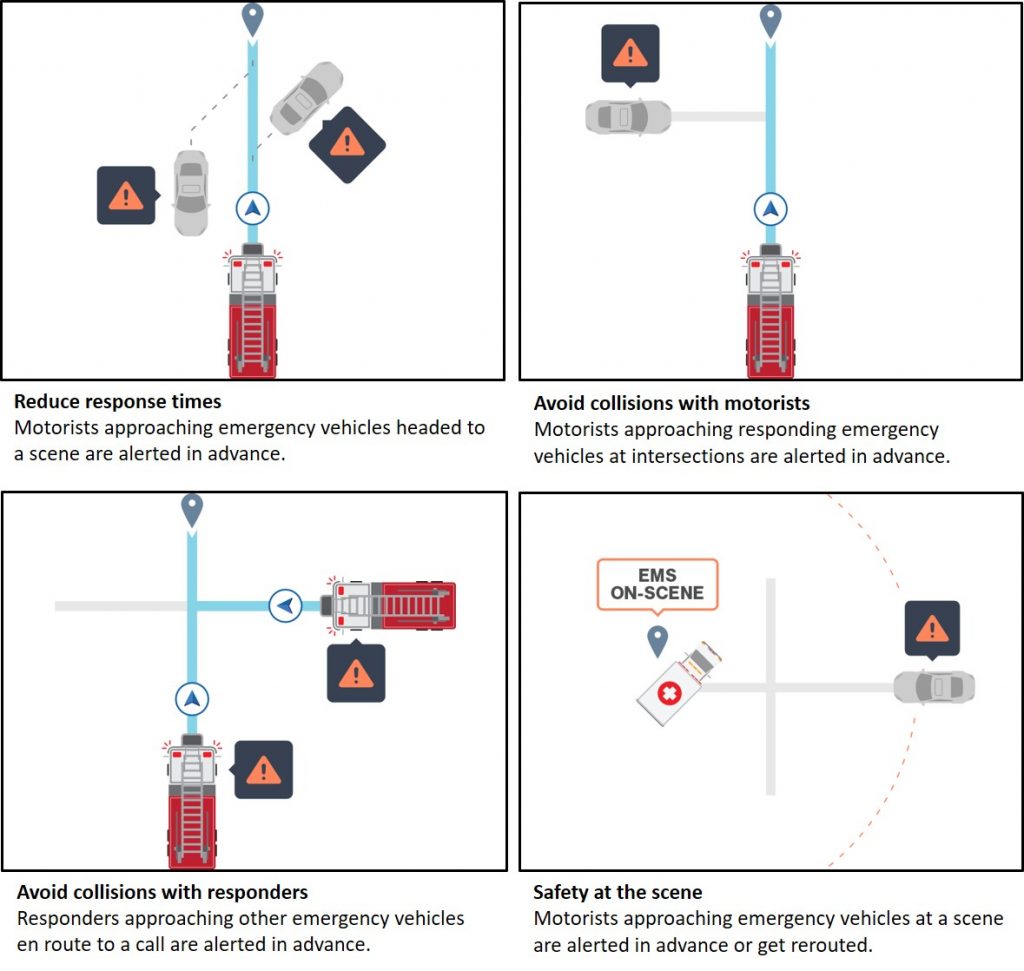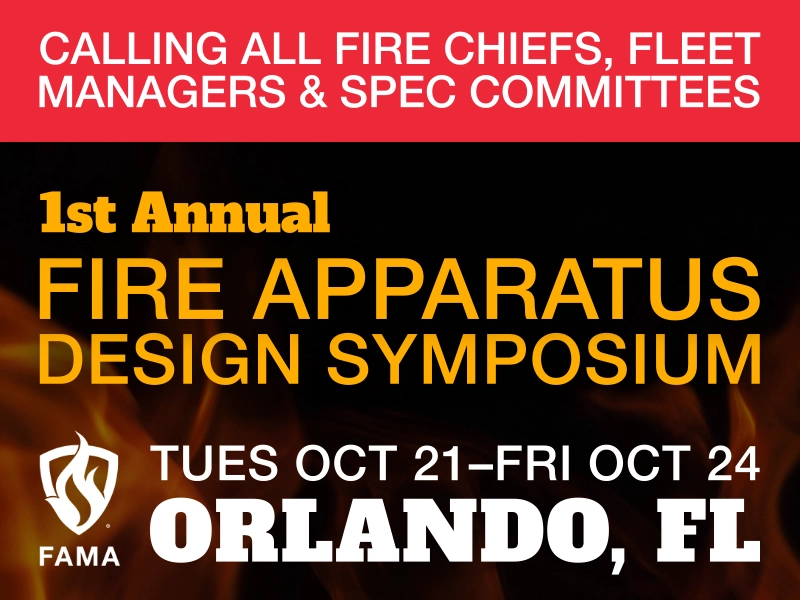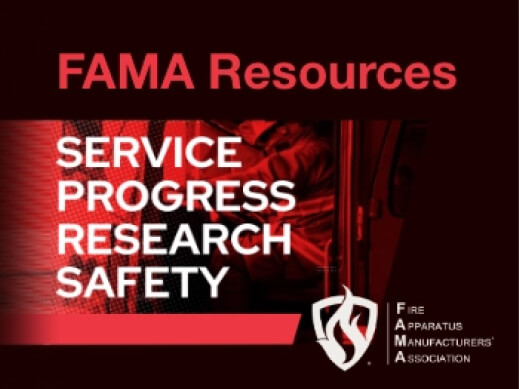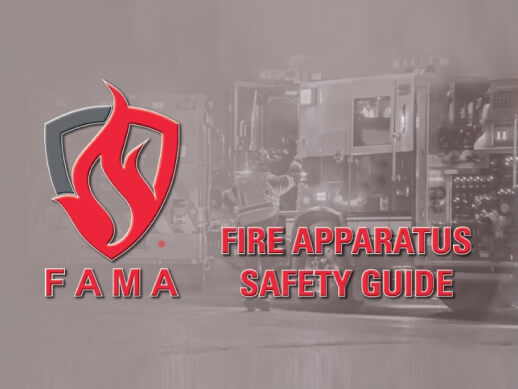When the call for emergency responders rings, the women and men who jump into action know there may be danger at the scene. But, the highest potential for danger actually occurs on the way to the call through collisions with motorists on the road. In fact, collisions are a leading cause of injury and death to emergency personnel.
The topic of vehicle-to-vehicle (V2V), or Responder-to-Vehicle (R2V) communication for emergency responders, continues to rise. To advance and protect the interests of the fire and emergency services community, we look to the Fire Apparatus Manufacturers’ Association (FAMA) to help facilitate healthy dialogue of such important and emerging safety topics. This article provides a general overview of R2V technology, why it’s important, and why solutions today simply aren’t doing enough.
It’s a common scenario: A fire crew is dispatched to an incident with sirens engaged and lights flashing—they’re counting on motorists to see them, hear them, and pull over. But, there are many impediments: the motorist does not see the flashing lights because he is distracted, or his nearly soundproof vehicle blocks out the siren noise, clogging the lane. Another motorist can’t tell where the truck is coming from so doesn’t react until it’s on his bumper. Or worse, a vehicle enters an intersection with the fire truck fast approaching, and a collision occurs. And, the same can happen between first responders rushing to the same scene.
The costs of such collisions are inherently obvious. It can cost cities upwards of $1 million any time injuries are sustained—the ramifications transcend physical injury, insurance, and legal costs, damage to vehicles as well as delays in the emergency crews reaching the original incident, which may worsen that situation.
Lights and Sirens
Everyone’s familiar with the sound of a blaring siren and flashing light, which we know means to pull over. But, driving behaviors today are making it more difficult to rely on that happening. The consumer driving experience has become highly refined and more luxurious, but it still ignores important factors. Auto manufacturers have introduced cars with near soundproof interiors and enhanced audio systems—so much so that drivers may not even hear the sirens at all—and in-dash infotainment systems plus mobile devices have drivers distracted with phone calls, texts, and content. By 2020, there will be more than 250 million connected vehicles on the road. Emergency crews cannot rely on motorists simply pulling over safely and quickly to let them through anymore.
Traffic Signal Preemption
Certain technologies are available to proactively give emergency vehicles the right of way by changing traffic signals or otherwise “preempting” traffic flow. While this can help prevent collisions at intersections, there are drawbacks. These systems require a direct line of sight to the emergency vehicle and will experience interference from the environment including weather, large passing trucks, and even tree branches. In addition, the cost of such solutions prohibits mass adoption, there is no outbound communication from that source, and the system works only within the city boundaries where the intersections are active.
Dedicated Short Range Communications (DSRC)
In recent years, automakers have made advancements in the development of important advanced driver assistance systems (ADAS) features. A few cars are even entering the roadways equipped with DSRC systems that enable V2V communication to transmit and receive messages about a vehicle’s speed, direction, and other information to help avoid a crash. While these systems are effective in situations where cars are about to bump into each other or when a driver inadvertently veers out of its lane, they’re insufficient because they only operate in close range. Motorists need alerts well in advance of encountering emergency vehicles moving at a high rate of speed in order to have enough time to react. Once the emergency vehicle is close enough for DSRC to detect, the window for preventive action is already closed.
Furthermore, the timeline for DSRC to be fully operational is decades out. It will be many years before auto manufacturers begin to include DSRC in consumer vehicles at scale and the infrastructure (e.g. traffic signal interfaces and roadside equipment to send and receive DSRC messages) isn’t built ye—nor has the “who will pay for it” been figured out as the costs are estimated to be in the billions. This technology was also set aside by the U.S. Office of Management and Budget, so its full implementation is unlikely.
Considering the future of autonomous vehicles at any level (0-5 scale), the importance of delivering “look ahead perception” through digital alerts using R2V and R2R becomes even more imperative (e.g. Culver City, CA incident where a Tesla on autopilot slammed into a parked fire apparatus on-scene).
How Do R2V and R2R Work?
Every time an emergency vehicle equipped with R2V/R2R engages in emergency mode, it sends a signal via mobile networks through to drivers indicating its nearby location and notifying drivers to use caution. When emergency vehicles come into the vicinity, the alert cautions the driver with a short message via the in-vehicle infotainment (IVI) system. The alerts also get delivered to motorists via navigation apps in wide use, such as Waze, that operate in-dash or on mobile devices. For responders to receive real-time notification, the alert can be delivered via an on-board screen or a separate device/transponder.
The key is seamless, real-time transmission of data. There are three aspects to this method:
- Transmission of data out: knowing where first responders are and when they are in “emergency” mode. [R2V/R2R outfitting of fleets can sometimes happen through direct integration with existing centralized systems or backends (check with your providers) or through after-market solutions.]
- Passing the data through a secure “cloud service” using existing mobile networks.
- Receiving the data in the form of an alert through car in-dash systems, navigation apps, and through to connected or “smart” city and traffic grids.
Studies have shown that reaction time improved when drivers had an advanced warning device (AWD) inside their vehicle. “Drivers reduced their driving speed earlier, used more controlled braking pressure (i.e., more controlled yielding) and tended to change lanes earlier to allow Emergency Services Vehicles (ESV) to pass.”1
“Another pilot simulation study conducted at the University of Minnesota found drivers using AWDs significantly increased safety margins (distance between civilian driver and ESV when ESV entered cross-traffic intersection), reduced civilian reaction time to ESV lights and sirens, and had significantly better braking control than drivers not using AWDs.
…The study’s simulation experiments found the odds of crash were between 60%…and 90%… lower among the drivers using AWDs compared to controls not using AWDs.”2
Some aspects to consider when searching for the right R2V and R2R solutions include
- Be sure vehicle alerts can be detected from close range and mid to far range. The solution should be able to accommodate a variety of road types, road speed limits, and traffic conditions.
- Inquire about the technology required for the system to work. It should depend on costly infrastructure, roadside equipment, or other “closed” proprietary solutions.
- The solution should support an inclusive ecosystem of new and emerging technologies (i.e. connected and autonomous vehicles, community infrastructure, navigation apps, other types of fleets, etc.). No one wants to replace an entire system a few years later.
- Understand the actual frequency or timing of a “real-time” solution. Some technologies consider “every one minute” as real-time, but that’s too long of a delay to provide alerts about responding emergency vehicles.
- Be sure the solution provider gives data and analytics back to cities, departments, and fleets. Too often, agreements are made that include fine print that doesn’t allow any access to the data at all or not without costly fees.
- Check that the technology is not using direct line-of-sight solutions with systems at intersections only. The solution should work anywhere emergency vehicles operate, which is everywhere.
- The solution should offer secure cloud services for all or most aspects of the service ecosystem.
- Be sure providers’ solutions are compatible with all vehicle electrical systems, including straight-wire and multiplex, especially if there is a mixed fleet, which is extremely common.
- Look for FirstNet-authorized and compatible solutions to ensure critical priority and delivery of safety-critical communication.
- R2R should be available simultaneously with R2V. Fleets should have the option to enable awareness between responders as well as with other types of emergency and rapid response fleets from both the same and neighboring communities.
- Consider downtime for vehicles. A solution should not require putting vehicles out of service in order to adopt.
- Don’t get sold an exorbitantly expensive solution.
Our vehicles and roads have changed drastically and will continue to do so. Highly attainable consumer technologies have made vehicles increasingly safer, yet the same vehicles are also more luxurious and sound-insulated. In-car connectivity, infotainment, and smart phones have drivers distracted and aloof of the road. It’s a big problem, and one that’s not going anywhere.
Public safety and emergency services have fallen behind the curve to advance similar advancements for our responders. Organizations such as the Vision Zero, Road to Zero Coalition and Together for Safer Roads are dedicated to reducing fatalities on our roads year over year. Our industry has a responsibility now, with the help of united organizations such as FAMA, to lead with more decisive action, engage with policy stakeholders, and influence regulation aimed at protecting those who serve and protect on the roads.

FAMA is committed to the manufacture and sale of safe, efficient emergency response vehicles and equipment. FAMA urges fire departments to evaluate the full range of safety features offered by its member companies.
Resources
- Lenné MG, Triggs TJ, Mulvihill CM, Regan MA, Corben BF: Detection of emergency vehicles: Driver responses to advance warning in a driving simulator. Drucker CJ: An epidemiological approach to emergency vehicle advanced warning system development: 2014.






